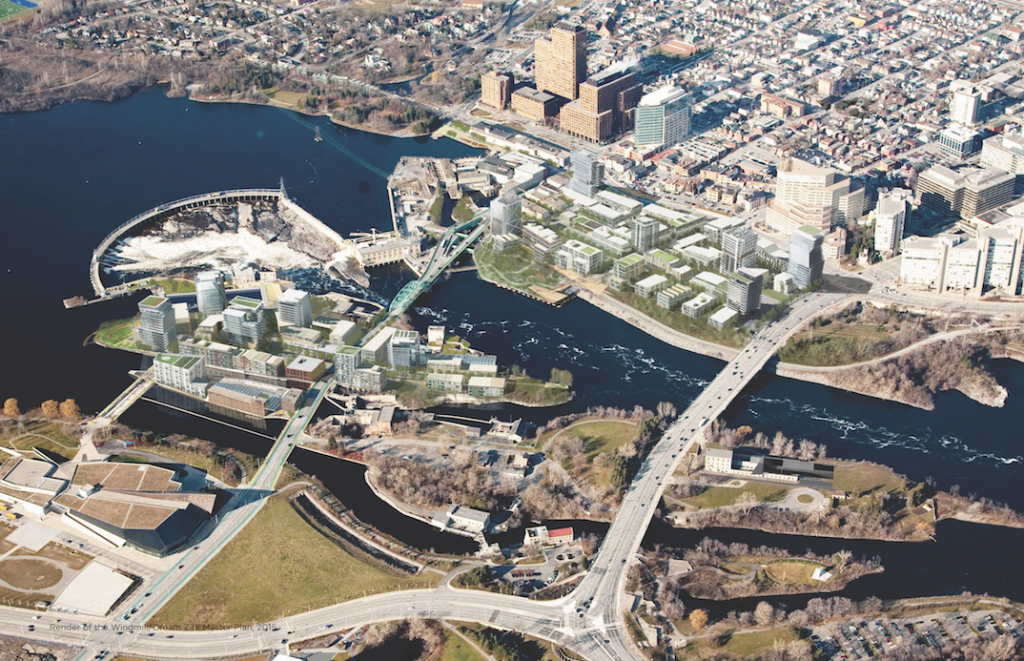City set to review Zibi heritage plan
By Laura Atherton
A detailed plan to document and preserve the cultural and historical value of the islands and shoreline around the Chaudière Falls — the site of Windmill’s controversial Zibi commercial-residential real estate development — is now under review by the City of Ottawa’s built heritage sub-committee, a significant step forward for the massive project.
The creation of a Heritage Interpretive Plan for Zibi was required by the Ontario Municipal Board to ensure that the history of the islands — and particularly its longstanding connection to the Algonquin people of the Ottawa Valley — is recognized.
The site where the Zibi development is to be built, which was purchased by Windmill in 2013, sits on unceded Algonquin territory and was the former location of Ottawa’s early industrial engine, lumber milling.
At a Dec. 1 committee meeting, one of the authors of the plan, Michael Stott, said the process for crafting the HIP involved consultations with members of the Pikwàkanagàn First Nation — located near Eganville, west of Ottawa — and the Algonquins of Ontario to ensure that their voices were heard.
“Those events weren’t about us coming and giving them something,” Stott said at the meeting, “It was about us going there and listening to what they wanted to see and really understanding how the intangible cultural heritage elements, as well as the tangible elements, could be put on site and in a respectful way.”
Although Zibi will consist of a number of private condo complexes housing thousands of residents, Stott said that the plan also aims to tell the history of the land through its public spaces.
“The important thing to remember is that what we’re talking about with the heritage interpretive plan isn’t the built form. It’s all about the public realm and open space,” Stott said. “That’s not to say that the plan could not be applied to the built form, but it really focuses on the need to explain the heritage of the site to the next generation of users.”
According to Stott, although previously there have been a few similar efforts, the Zibi Heritage Interpretive Plan is the first of its kind in Canada, and it was stated at the meeting that the document should set an example for heritage preservation at other sites in Ottawa.
David Jeanes, chair of Heritage Ottawa, said the preservation of the area’s heritage is key to understanding the role that the Chaudière Falls played in the establishment of Ottawa as a manufacturing city up until the early 1900s.
Before manufacturing on the islands ceased, the Chaudière Falls were responsible for powering the machinery in a sprawling complex of lumber mills unmatched in size and productivity in North America.
Long before industrialization in the 19th century and the construction of a major hydroelectric dam in the 20th century, early European explorers of the Ottawa Valley — including France’s Samuel de Champlain — expressed wonder at the size and turbulence of the waterfall.
“At one point, the Chaudière Falls were considered almost as important as the Niagara Falls,” said Jeanes.
Jeanes said he is supportive of Windmill’s heritage plan, saying that in terms of public access, it will mark a significant improvement to the existing site.
“It’s very important that they’re finally providing ways for people to actually walk and look at the Chaudière Falls themselves,” said Jeanes. “Previously, that was almost impossible because except for walking across the Chaudière Bridge on certain days when they’d opened up the ring dam and there was a lot of water from the falls, it was just a pile of rocks.”
Although First Nations representatives have been involved in various stages of the planning of Zibi, some Indigenous critics have argued that the project threatens the Indigenous cultural heritage of the site and that the interpretive plan isn’t enough.
Indigenous architect Douglas Cardinal said that the planned Zibi development runs counter to what the land should be used for, according to Algonquin tradition. He has argued that Zibi clashes with the vision championed by the late Algonquin elder William Commanda, who had wanted the area to be used for a national Indigenous cultural centre.
Cardinal — who designed the Canadian Museum of History — has drafted plans for such a complex to be built on nearby Victoria Island.
While Victoria Island is not included in the Zibi plan, Cardinal and other critics have argued that commercial development on adjacent sites will damage the cultural integrity of the area.
The islands were originally a place of meeting for not only Algonquin people, but Indigenous travellers from all over the continent. Cardinal contends that by building private condos on sacred land that was once a welcoming environment goes against the very meaning of Ottawa (“to trade” in Algonquin language), which gets its name from the fact that it was a place where people could come to exchange goods in peace.
For Cardinal, creating a plan to preserve the heritage of the area simply isn’t enough.
“You don’t come in and destroy someone’s sacred land with a bunch of condos,” he said. “It doesn’t matter what name you call it, it’s still an affront to do that.”

